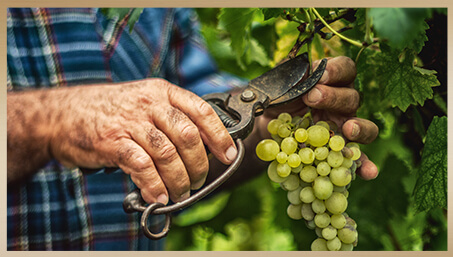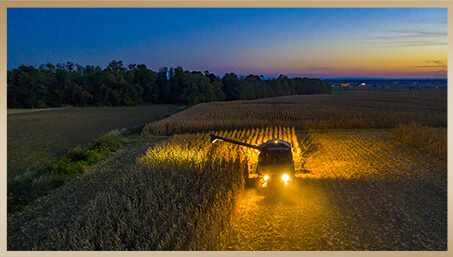
Harvest

The glow of headlamps in the darkness, stacks of yellow picking bins at the end of each row, the dull murmur of the tractor pulling the gondola of grapes and voices echoing through the vines — these are the sights and sounds of the grape harvest. For millennia, the practice of harvest has been a way to celebrate the end of another growing season. Talk to any growers and you’ll sense their passion and devotion to the land and the vines. There is a mutually beneficial relationship between the vines and their caretaker — a symbiosis. Many growers, refer to the vines as their children, and the vines respond to nature and nurture, just as children do. The nurture never stops, but nature can be unpredictable.
Growers have long understood the importance of low intervention in the vineyard. Hospitable climate, soil and water are all grapevines need to grow, but the vintner’s decisions and cultural traditions give wine its distinctiveness. Education and training are important, but growers’ hands-on experience guides their decisions too.
In the Northern Hemisphere, autumn is an exciting time of year in wine country. The vineyards come alive with activity and the rush of harvest. Tending vines is a year-round endeavor, and all the effort culminates with harvest.
When to pick is one of the most important viticultural decisions a grower makes. Once the grapes have reached peak ripeness, it’s all hands on deck. The quality of grapes at harvest determines the quality of the wine.
The first grapes to arrive in the cellars are Chardonnay and Pinot Noir for sparkling wine. The grapes must be ripe yet higher in acid and lower in sugar than grapes for still wines. This moment usually occurs in August, and by September, harvest crews are in full swing. If you ever have the opportunity to witness a harvest, you will have a new appreciation of wine.

TIME TO PICK
Winemakers and growers walk the vine rows tasting grapes every day prior to harvest. They rely on their experience, but they’re also checking sugar levels. Each year brings different challenges, and winemakers have one shot at giving the green light to pick. The longer the grapes hang on the vine, the more sugar they accumulate and the less acid they retain. Winemaking style plays a key role in decisions about when to pick.
For quality, growers like to harvest at night and in the early morning hours when grapes are cool. The grapes arrive at the crush pad before temperatures begin to rise. Harvest activities are very well orchestrated. The pickers work rapidly in the cool evening air, aided by headlamps and lights from the tractor.
Is it Better to Harvest Grapes
Mechanically or by Hand?
For some wines, hand harvesting is a must. Champagne and other traditional sparkling wines require whole clusters, as do carbonic maceration wines such as Beaujolais. Mountain vineyards may also require hand harvesting if the hills are too steep for machines. Hand harvesting is more precise and gentler, so the grapes remain whole and don’t oxidize.
Machine harvesting is more efficient and may be more cost-efficient, considerations for large wineries. Typically, grapes are shaken off the vine by flexible rods. Some damage to grapes is inevitable so as a precaution, sulfur dioxide is added to prevent oxidation. The vines need to be trellised so that the fruit grows in a limited zone that the machines can access. The harvesters also need plenty of room between the rows and at the end of the rows to turn around. Harvesting machines are expensive, but they reduce labor costs.

Transportation to the Winery
Ideally, a grower wants to deliver the grapes to the crush pad unscathed, with no bruised, crushed or broken berries. The winemaker wants all the juice released in the winery — not in the picking bin. If the winemaking crew can’t process all the grapes immediately, they may refrigerate the grapes until they can be processed. Once the grapes arrive at the winery, vinification and aging begins, a process that can last anywhere from months to years.
2021 Vintage Notes
The 2021 vintage is one for the history books. On the West Coast, heat and drought are bringing ripening and irrigation challenges. Water stress may encourage a vine to put energy into the fruit rather than the leaves, resulting in concentrated flavor. But excess water stress is detrimental, compromising growth, yield and quality. Growers who irrigated early are noticing that their vineyards are in good shape. As harvest approaches, temperatures have remained steady, promoting slow, even ripening. Early predictions are that yields will be below average.
The Pacific Northwest was especially challenged this year with temperatures reaching triple digits and pushing the harvest 20 days ahead of normal. When temperatures remain consistently high, sugars accumulate too fast, grapes shrivel, and vines can shut down.
Europe has also experienced extreme weather conditions in 2021. Late frosts in April in Bordeaux and Burgundy have resulted in a 24% to 30% drop in yields. Similar reports are coming out of Italy, Spain and Germany. The Côte-Rôtie reports losses of 50%. Germany suffered additional damage from widespread flooding, with great losses in the Mosel.
Vintage variation is a given. Weather has a significant impact on the growing season, and each year wine lovers appreciate the nuances that every new vintage brings to the bottled wine.
